There’s a Bug in My Book! 6 Book-Loving Pests
There’s a Bug in My Book! 6 Book-Loving Pests
Sometimes, it can feel like nothing in your home is safe from pests. We know that they love to hide in our homes from the heat of summer and the chill of winter, which means that they can find the tightest corners to make their new homes and stay safe. One potentially unexpected place they love is the bookshelf, and in books themselves. This may come as a surprise, but if the books are largely undisturbed, they provide the perfect home for a homeless pest family.
Why Do Bugs Love Books?
It’s obvious why we love books; by reading, we can escape to new worlds and stories through our imaginations influenced by words on a page. But to our knowledge, insects and rodents can’t read. So why do they like to be near books so much? There are a few different reasons why pests gravitate towards books. One factor is any type of mold that develops in books. When paper products get wet and aren’t properly dried out, they can develop mold. Any type of excessive moisture or humidity in the air attracts insects because it keeps them cool and creates the mold that they love. Pests love this environment because they feed upon organic materials. Another factor with paper is that it contains starch and cellulose, two more favorite foods of common pests. These natural ingredients make for a delicious meal for the pests that dare to disturb our library.
Another reason why you may be finding insects in your books is common, albeit a shudder-inducing one: they were already there. Pests can stay in hiding for quite some time if they have food and water available, so a bookshelf that is near the kitchen or organic matter can contain insects for a long time before we notice. This is another reason why it is important to have an inspection done either before or during the process of moving into a new home, so that it will hopefully find any pests that would be all too happy to move into your furniture and belongings. Pests can also invade your home by way of travel belongings after a trip. Bed bugs are notorious for hitching a ride on suitcases and clothing while traveling, which gives them free-reign for roaming your home and hiding in places that they have access to warm blood.
No matter how or why they gain access to books, it is still annoying to open up an old classic and find a bunch of small holes in the pages. If there are small holes, bite marks, yellowing, insect casings, and shredded edges in the pages of your books, chances are very high that at least one insect has made its way into your collection. There are quite a few different types of pests that commonly enjoy invading books with their own methods and reasonings, but these are the most recurrent visitors of the pages in our written works.
Rodents
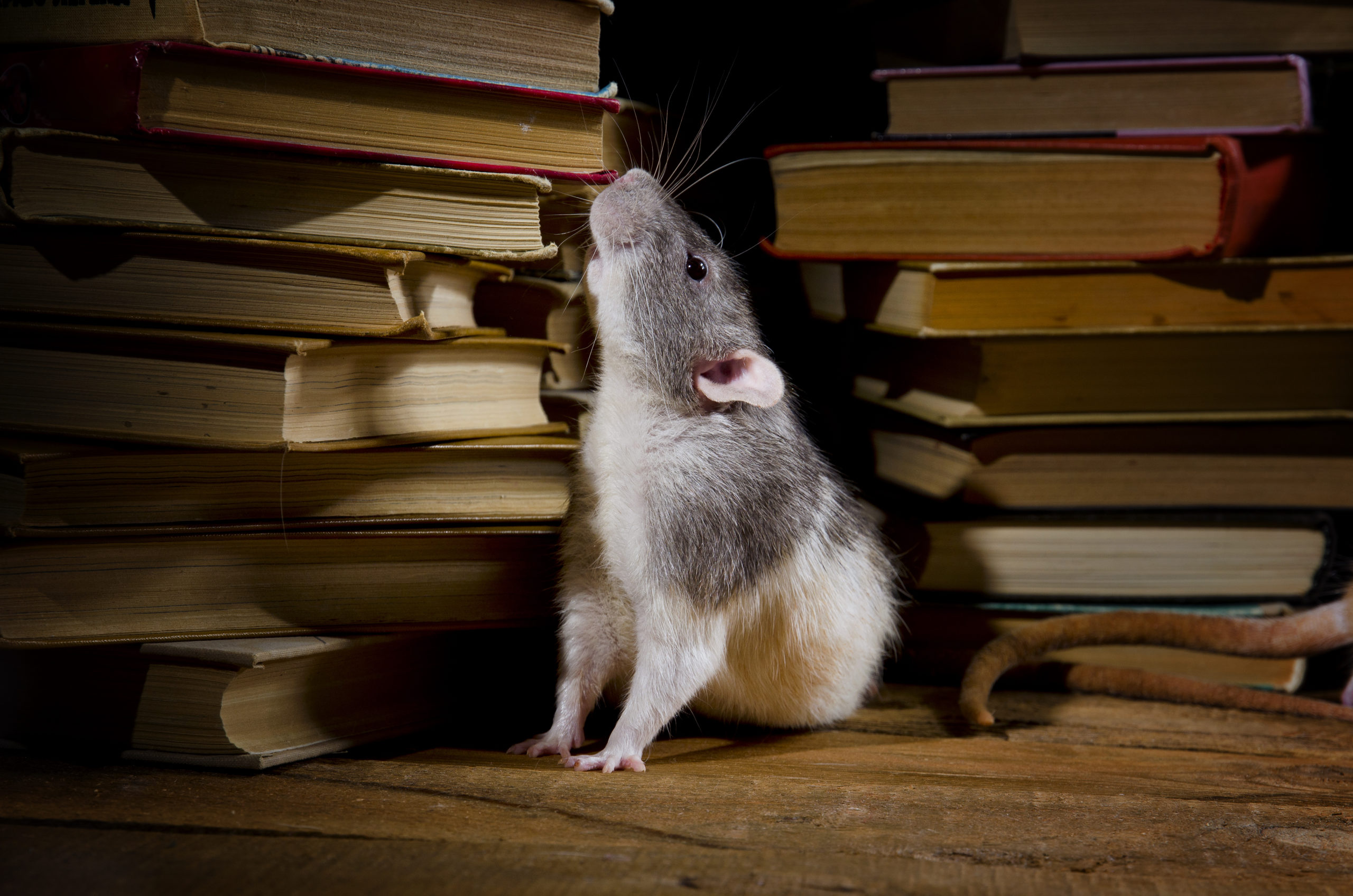
Rodents are larger and would be obvious if you found them in a book, but the evidence of their presence that they leave behind is smaller. There will likely be bite marks, tears, and rips in books that have been visited by rats, especially if the books are on the floor. The main reason for rats and mice tearing books apart is to get nesting materials. They love using shredded paper and clothing materials to build their nests since they can provide a cozy structured environment for their babies. If a rat or mouse finds your book collection interesting, it’s not because they are looking to learn anything, like a certain talented rat from that beloved Pixar movie. They will ruin the pages, and their droppings are no fun to clean up either. You can always keep small traps around the book case, but we know that’s not very aesthetically pleasing. The best way to prevent this problem is to keep an eye on your books and not let them go untouched for too long.
Roaches
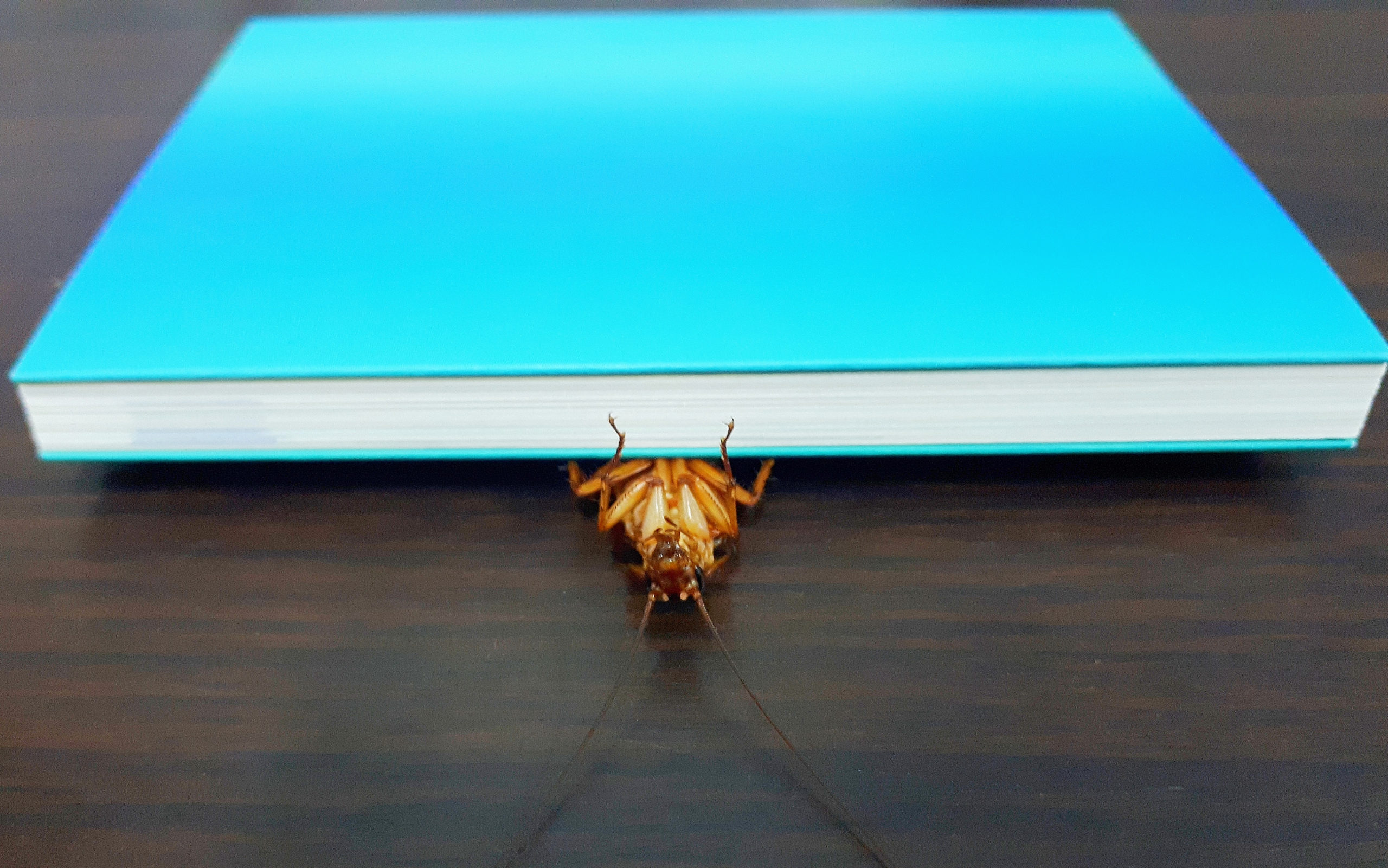
This is another very annoying pest to try to eliminate. Roaches have established a reputation as being indestructible and the most likely to survive a nuclear attack. While this is not true (to our knowledge), they are definitely hard to get rid of once they find something they like in our homes. They are natural scavengers, meaning that they are on the constant search for food anywhere that they go. The materials that are most attractive to them are starch and sugar, which are found in the pages of a book. Roaches hide in paper or cardboard materials that are often found around books, especially if they are in a box in the garage. They will turn to paper for food when nothing else is available. They can actually convert the starch into glucose to give them more energy and sustenance. Roaches use their saliva to break the starch down into glucose, which they then consume. This results in some hole-y (not holy) pages and some satisfied cockroaches. Similar to the rodents, it’s a good idea to check the bookshelf once in a while to make sure that no invaders have found the pages interesting for the wrong reasons.
Booklice
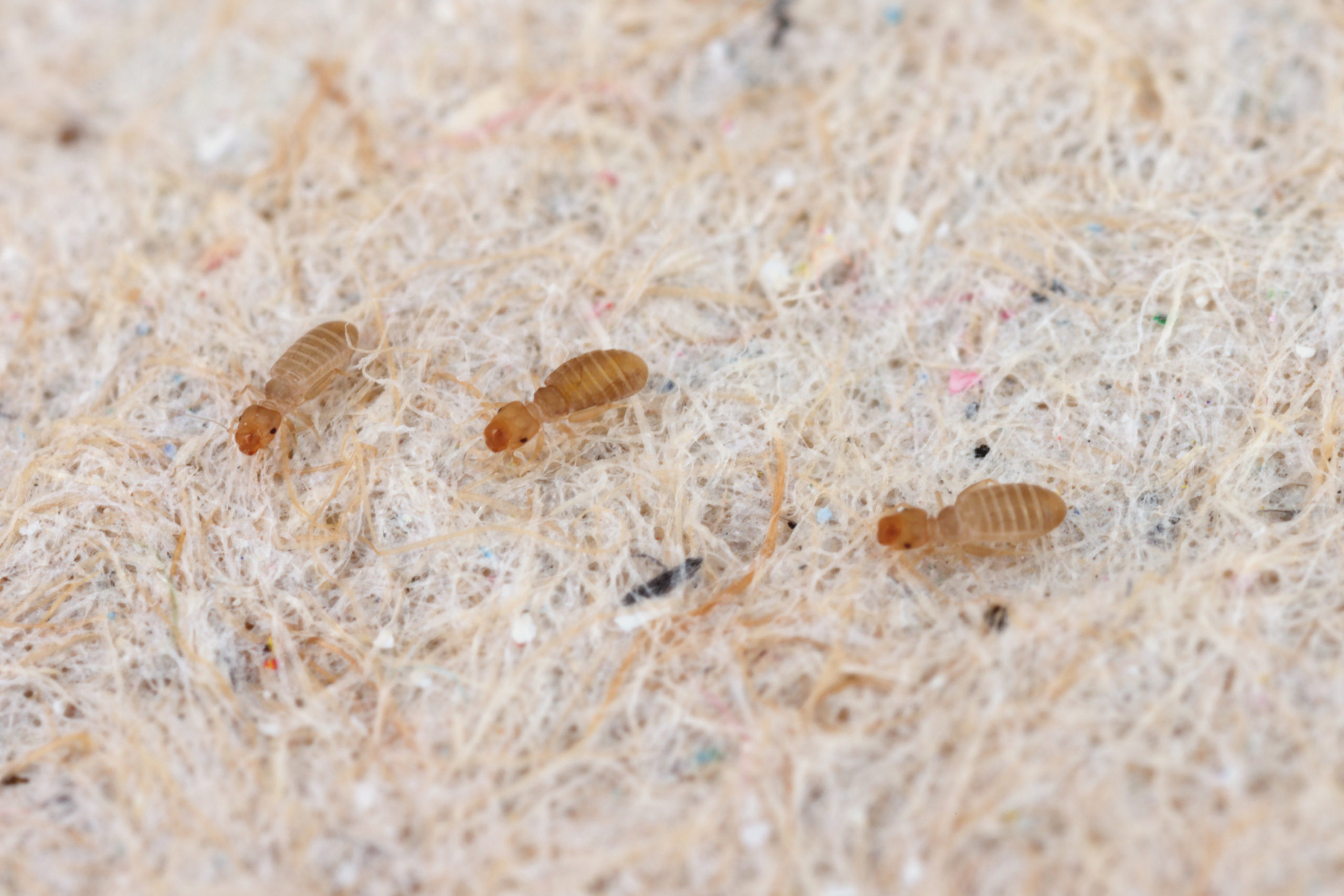
This is a much more frequent enjoyer of books than the previous two. Booklice are tiny white paper mites that measure at no more than .02 inches. They can resemble termites when closely examined, and can have tiny wings that help them travel from book to book quicker. But their preferred method of travel is to hop around, which is to their benefit since they’re so small. Booklice are more frequently found in the winter when they come inside our homes to hide from the chilly weather. They don’t do much overall damage to the pages since they are so small, but they will leave the papers with a fuzzy texture and a slight odor. They are mainly drawn to damp areas, so leaking pipes and drains are a huge attractor. They multiply fast, which means that a booklice invasion will lead to a potential colony in your library. They are also in the category of pantry pests, meaning that they can be found in pantries that hold dried foods. Their favorites include grains, flour, pasta, and cereal. So unfortunately, booklice won’t stick to the bookshelf. You can help reduce the population and prevent an invasion by vacuuming the area semi-frequently, as well as reducing the amount of damp areas in the home. Sharing is caring, but it doesn’t mean we need to share our books with booklice, even though it’s in their name.
Bookworm
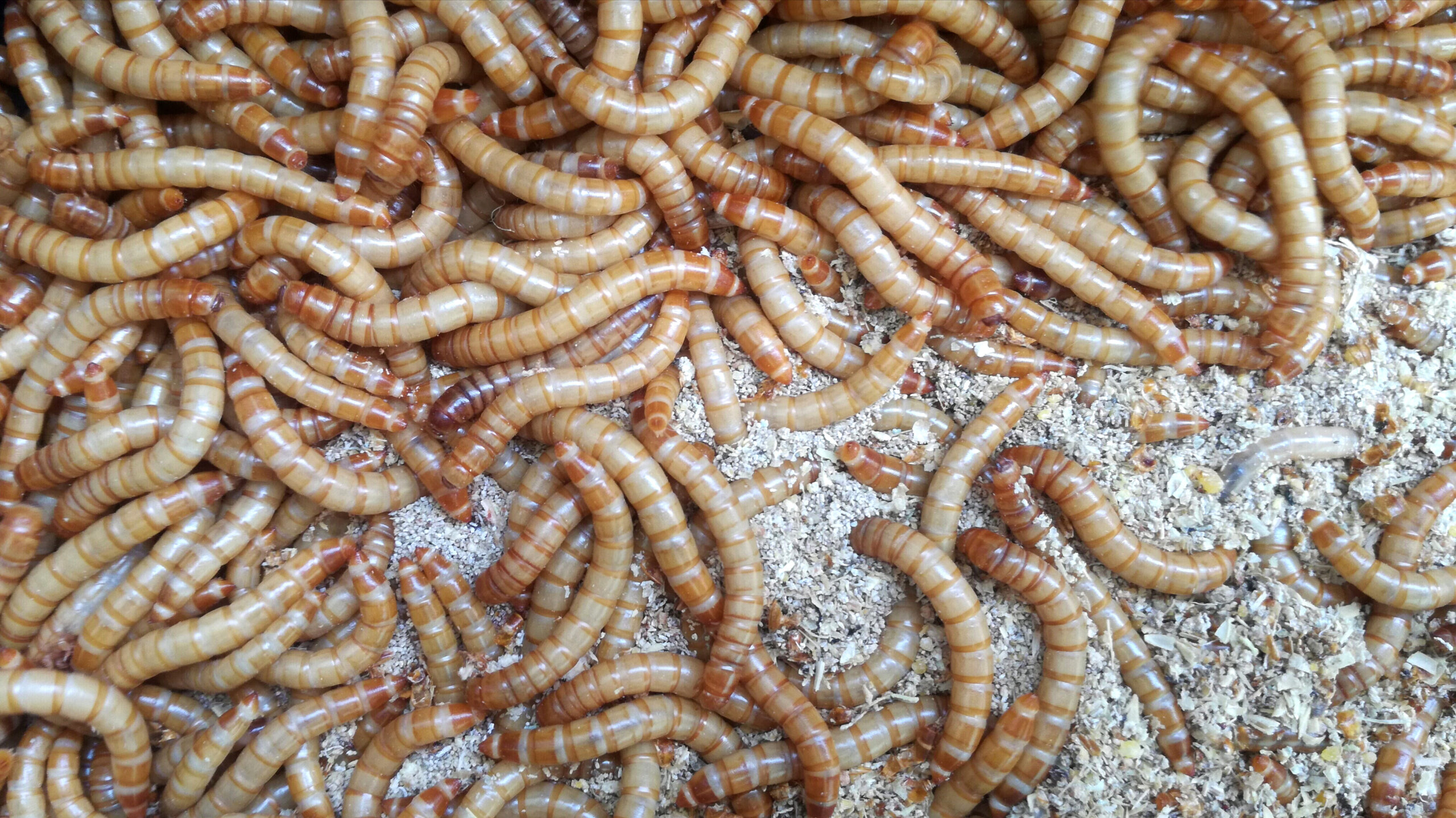
When you hear the word “bookworm,” you likely think of a poster depicting a green worm with glasses and a stack of books on the walls of the public library’s children’s section. But it is a real insect! Well, technically a group of insects. The term “bookworm” refers to the larvae of many insects, including beetles, booklice, moths, silverfish, termites, and cockroaches. These larvae eat paper products, which is why they are drawn to printed publications. They are white or yellowish in color, and are clearly very small. When the eggs are laid inside or behind wood, like a bookshelf, the larvae will eat through the wood as an appetizer when they hatch. Once they reach the books, they are capable of eating through the covers and reaching the pages. One specific bookworm larvae, the carpet beetle, loves genuine leather covers from old books. They will leave behind a cluster of chew marks on the cover and pages, which is annoying to find in your vintage collection. One common way to ward off larvae is to keep the book area clean by dusting and not letting older books sit idle for too long. Also, some essential oils smell awful to pests, so it wouldn’t hurt to diffuse some oils in the area if that is something you enjoy.
Silverfish
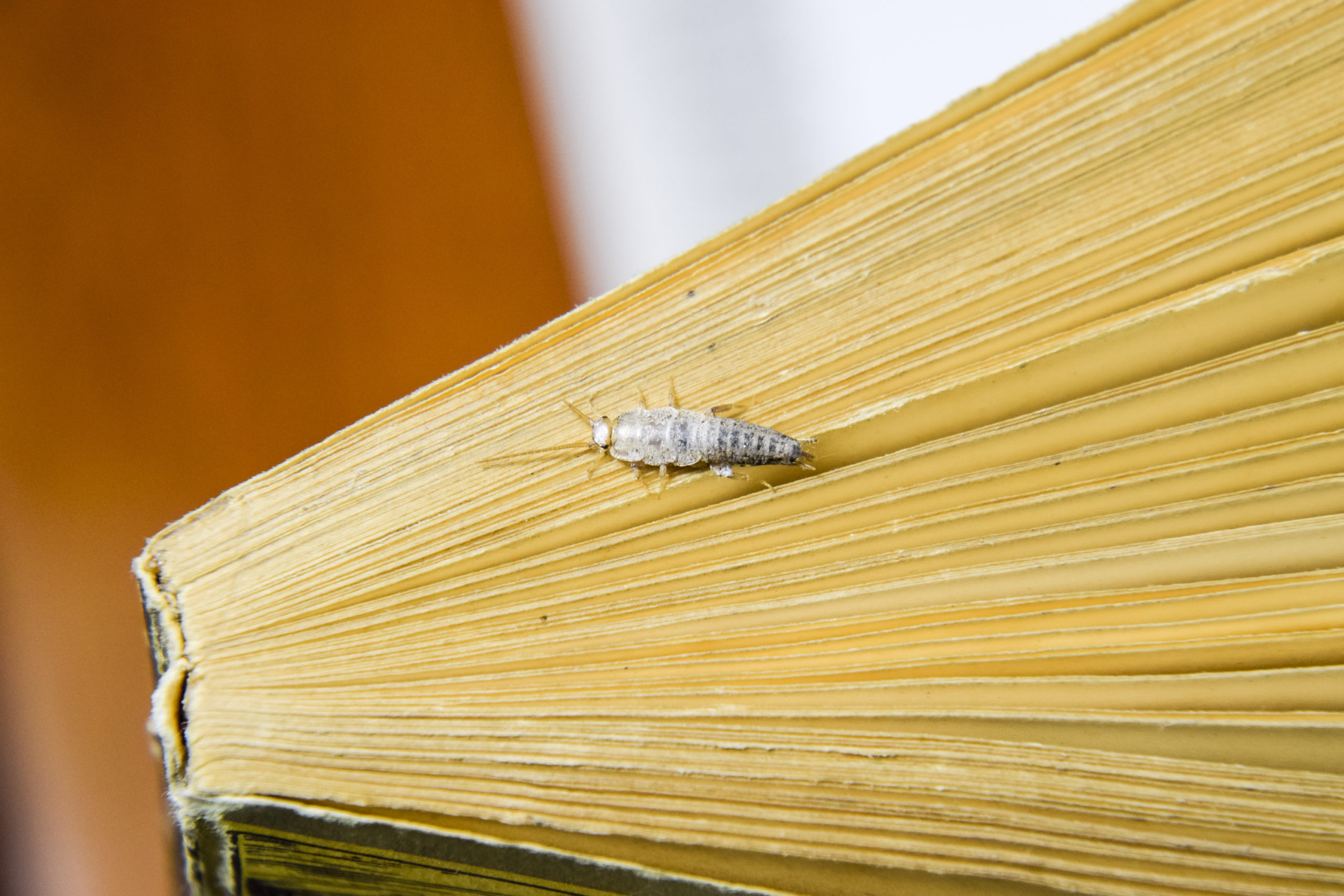
These shiny pests are creepy to look at, but they are harmless to humans. But that doesn’t excuse their tendency to invade our books. They mainly invade in the spring and summer when the weather is warmer, and they are actually often found in the bathroom because of the humidity. But since silverfish love starch and fiber, the pages of books are irresistible to them. They will eat most of the book, consuming parts including paper, binding, and glue. This is one of the more destructive book pests, despite their otherwise tame demeanor. They leave tiny holes and yellowing pages in their wake, which definitely downgrades the quality of the book pages. Silverfish won’t do anything to you if you stumble across a live one, but they aren’t friendly to books and should therefore be taken care of as soon as you find the signs.
Termites

Nothing good comes out of having termites in your home. If they’re not eating through the framework of the house, they’re chewing through your belongings. Not to mention, they are next to impossible to eliminate without professional help. The main and easiest way that termites invade your books is when the bookshelf is connected to a wall in some way. If the termites are already in the walls, they can easily chew through and make their new home in the shelf to eat the wood and the books. They can devour books easily, especially when the whole colony turns their attention to the books. This problem is frustrating and it is easy to want to take care of it yourself to eliminate it immediately. But if there is one pest that you don’t want to DIY your way through an infestation, it’s the termite. They are extremely difficult to get rid of, and multiply quickly so that the colony is larger than we may think initially. Pest control is crucial as soon as you think you have termites in any area of the home so that you can hopefully avoid paying for excessive damages and not further deal with termites in your space.
Pest Control is Well-Read
The best ways to prevent pests from invading your books are to keep the books off the floor and to keep food away from the pages. Books that are stacked on the floor are inviting to all pests, since they’re easily accessed and not obstructed by furniture. It’s very relaxing to read while enjoying a snack, but any leftover crumbs or spills stuck in between pages are inviting for all pests. If you do happen to spill something on the book, make sure to brush out the crumbs or dry out the spill before sticking it back on the shelf.
It’s fun to read and escape into different worlds through books, but it is not enjoyable to find your beloved library ravaged by pests. Our pest control team is here to help with any level of pest infestation, and will also provide preventative treatments to ward off any future infestations. Contact us at any time to learn more about our services and how you can enjoy your books without the interruption of pests.
Citations
5 bugs that eat books and paper. (n.d.). How to Murder Pests. Retrieved on April 13, 2022, from https://howtomurderpests.com/bugs-that-eat-books-paper/
Nicoll, G. (2021, December 17). How to protect your books from bugs. Book Riot. Available at https://bookriot.com/how-to-protect-your-books-from-bugs/ (Accessed on April 13, 2022).
8 Creative Ways to Have a Pest-Free Fourth of July
8 Creative Ways to Have a Pest-Free Fourth of July 8 Creative Ways to Have a Pest-Free Fourth of July Summary: The Fourth [...]
A Simple Guide to Preventing Stinging Pests
A Simple Guide to Preventing Stinging Pests A Simple Guide to Preventing Stinging Pests Summary: Stinging insects are more active in warm weather, [...]
These 10 Natural Mosquito Repellents Can Actually Help
These 10 Natural Mosquito Repellents Can Actually Help These 10 Natural Mosquito Repellents Can Actually Help Summary: Natural mosquito repellents are easier to [...]
How to Get Rid of Carpet Beetles
How to Get Rid of Carpet Beetles How to Get Rid of Carpet Beetles Summary: Carpet beetles are sneaky pests that don’t usually [...]
How Do Roaches Affect Asthma and Allergies?
How Do Roaches Affect Asthma and Allergies? How Do Roaches Affect Asthma and Allergies? Summary: It’s no secret that pests impact human health, [...]
These 5 Carnivorous Pests Might Surprise You!
These 5 Carnivorous Pests Might Surprise You! These 5 Carnivorous Pests Might Surprise You! Summary: There are many eco-friendly ways to prevent pests, [...]

